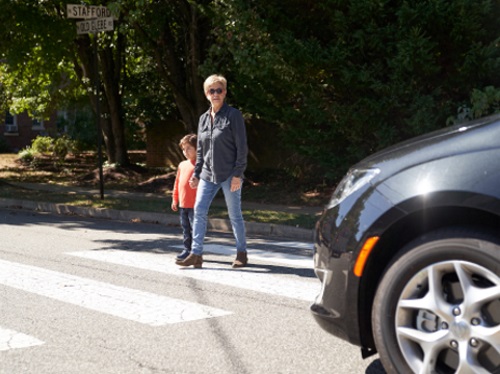University of Connecticut Professor John Ivan recently received a $200,000 grant from the Connecticut Department of Transportation to investigate the safety of a proposal to improve the “uniformity” of pedestrian crossing signals statewide.
[Above photo by Connecticut DOT]
Currently, intersection signals under the Connecticut DOT’s jurisdiction use one of two kinds of pedestrian signals. Some use a “side street green” scheme, which means pedestrians can cross a major road while cars on that street have a red light, but cars on a smaller side street have a green light.
Others, however, use “exclusive signals” for pedestrians, displaying “Walk” or “Don’t Walk” visuals often accompanied by a timer that lets walkers know how much time they have left to cross the road.

[Editor’s note: The U.S. Department of Transportation is marking October as “National Pedestrian Safety Month.” National Pedestrian Safety Month celebrates the right of everyone to walk or roll safely and reminds drivers of their responsibility to stay alert for pedestrians, cyclists, and other vulnerable road users. The agency noted that, in 2020, 6,516 pedestrians died in the United States – an average of 18 pedestrians a day. Yet for 2021, the agency is projected a 13 percent increase in pedestrian fatalities compared to 2020.]
Professor Ivan’s recently team recently found that intersections using “exclusive” pedestrian signals experienced fewer “severe conflicts” between pedestrians and vehicles – situations where a pedestrian-vehicle collision is deemed imminent.

Yet the same study also found pedestrian compliance with signaling was higher with “side street green” phasing than with exclusive phasing signals.
As a result, the Connecticut DOT is considering implementing “concurrent” phasing – installing clearer pedestrian signals in areas that currently use side street green phasing.
This means pedestrians would still cross the major road while the minor side street has a green light. That plan would also add “Walk” and “Don’t Walk” icons currently used with exclusive phasing to these intersections – improving signal uniformity statewide and reducing the chances of pedestrian confusion.
According to a blog post, Professor Ivan and his team will evaluate the safety of the proposed change from side street green to concurrent phasing, analyzing changes in expected crash experience, distribution of the severity of pedestrian-vehicle interaction, plus pedestrian and motorist compliance with the new signals.
 States
States
NCDOT Staff Participate in ‘Explosive’ Technical Training
December 19, 2025 States
States

